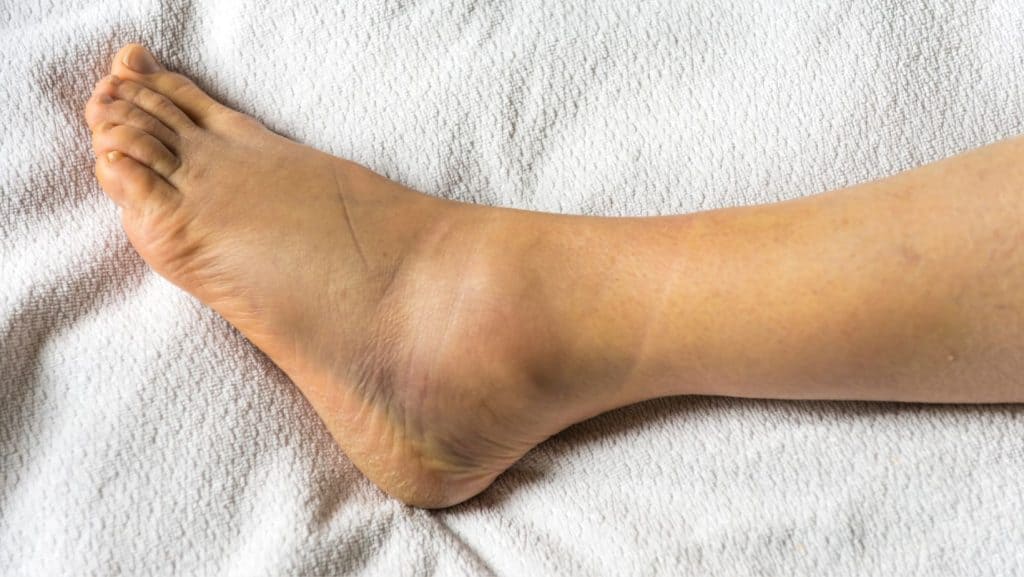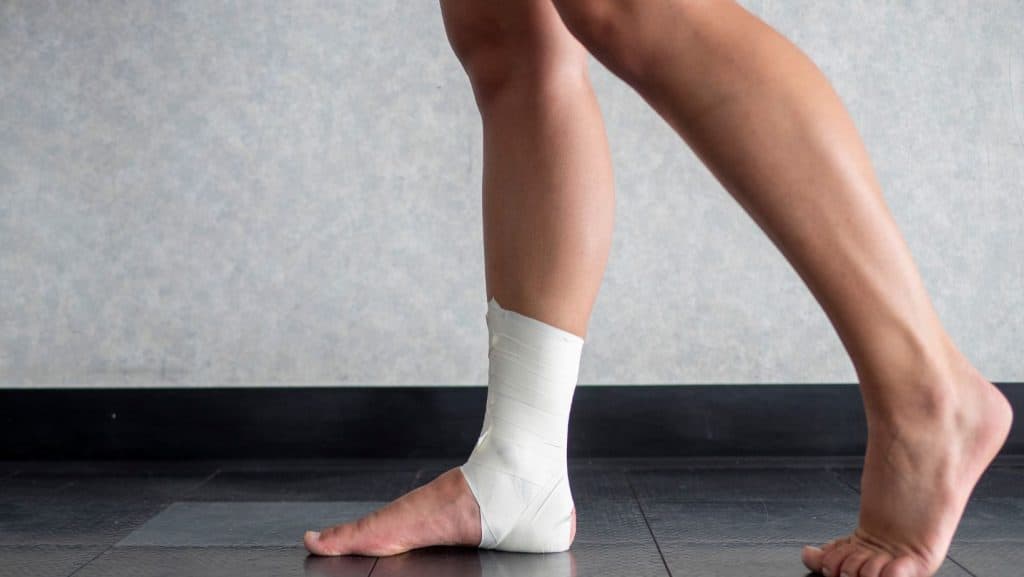Best Ankle Brace
Read More >
Ankle sprains are common soft tissue injuries that can cause pain and swelling on the outside of the ankle. A ligament attaches two bones, and there are 3 lateral ligaments on the outer side of the ankle.
If the lateral ankle ligaments become stretched through the rolling of an ankle, they can become irritated and painful. This is the most common type of soft tissue injury to the ankle, referred to as a sprained ankle. A Lateral Ligament Ankle Sprain can result in pain and swelling on the outside of the ankle. In most cases, these injuries can be managed and resolved with appropriate home care, but in some instances, they require the input of a medical professional.
The 3 most commonly affected ligaments from an ankle sprain are the Anterior Talo-Fibular Ligament (ATFL), Calcaneofibular Ligament (CFL) and Posterior Talofibular Ligament (PTFL). The ATFL is positioned nearest the front of the ankle, the CFL is in the middle of the three, and the PTFL is positioned towards the back of the ankle.
The function of the lateral ankle ligaments is to provide support and stability to the ankle while providing resistance against the inward rolling of the ankle. The lateral ligaments play a vital role in the proprioception of the ankle joint (awareness of where your ankle is in space), and when you have a sprained ankle, your proprioception diminishes, and this is one of the key reasons that you have a high risk of recurrence.
In this article, we will explore all there is to know about ankle sprains, how to treat them at home, and what care under a medical professional entails.

In the United States, there is an ankle-sprain incidence rate of 2.15 per 1000 person-years. The highest incidence age group are 15-19-year-olds with an incidence rate of 7.2 per 1000 person-years.

There are 3 broad classifications of ankle sprains relevant to the severity of ligament tear. Learn the symptoms of each below.
The ligament is mildly overstretched, leading to pain in the outer ankle. Having no swelling for a grade 1 ankle sprain is not unusual. These often happen innocuously, such as walking on an uneven surface with no pain at the time of injury but delayed pain up to 24 hours after.
There may be mild yellow bruising, but it is not uncommon to have no bruising. As the injury begins to heal, there may be an itchy sensation on the injury site. There is no ligament instability with a grade 1 ligament sprain.
A grade 2 ankle sprain is a partial tear of one or more lateral ankle ligaments. It is often the result of a sudden movement, such as a fall or slip when changing direction.
It is associated with an immediate onset of pain and swelling within 24 hours of injury. A purple bruise may appear on the side of the ankle, and this may seep down to cause bruising to the side of the foot due to gravity.
Walking can be painful but not impossible, with the worst pain when changing direction or inverting the foot, while there is normally less pain when moving in a straight line. Pain can be worse at night after use during the day.
A grade 3 ligament sprain is a complete tear or rupture of one or more of the lateral ankle ligaments. It is the result of a very sudden or sharp movement or fall.
There is often a loud pop or click with immediate swelling and pain. It is common not to be able to walk or weight-bear with a grade 3 ankle sprain.
Swelling may appear like a lump in the shape of a tennis ball on the side of the ankle with bruising all along the ankle and foot.
In the early stages of injury, there may be a throbbing pain at rest, and it is not unusual to have numbness or pins and needles in the toes due to large amounts of swelling. When weight-bearing, the ankle can feel unstable.

In most cases, a clinical assessment with a Physical Therapist is sufficient to establish a diagnosis for an Ankle Sprain. Suppose a Physical Therapist is unsure of the severity of the sprain or wishes to exclude related conditions such as an avulsion fracture.
In that case, they may refer for an MRI, the most accurate form of scan for an Ankle Sprain. An ultrasound is a cost-effective alternative, while an X-ray cannot diagnose an ankle sprain.
Anterior Drawer Test Ankle: Croy et al. 2013 study defined two cut-off points for talocrural joint laxity. The first was set at 2.3mm or greater in the talofibular interval, and the second was at 3.7mm or greater. Values for sensitivity and specificity were 74% and 38% for the first interval and 83% and 40% for the second interval.
Talar-tilt Test: Rosen et al. (2015) found this test to have a sensitivity of 4% and specificity values ranging from 78-88%.
Reverse anterolateral drawer test: has a sensitivity of 87% and specificity of 91% compared to ultrasound scanning.
We always recommend seeing a medical professional such as a Physical Therapist or a Sports Medicine Doctor, if you have any symptoms of an Ankle Sprain. Where this is not possible, the best home remedy is the acronym PEACE & LOVE.
P: Protect the area of injury for 1-3 days through offloading and a short period of rest. This allows the fibers of the torn ligament, a chance to begin the healing process.
E: Elevate the injured area to reduce swelling and inflammation in the affected area. This can lead to bruising up the leg but it is normal.
A: Avoid anti-inflammatory medication such as Ibuprofen as this can have a negative effect on the long-term healing of soft tissues. Our bodies have a very efficient set of healing stages and inflammation plays a key role in this so it should not be disturbed where possible.
C: Applying compression to the injured area with an elastic bandage can allow inflammation and swelling to occur but it can help to manage the volume of swelling.
E: Education in anatomy, healing response, and recovery process are vital. This enables optimal recovery by knowing what to do and not do during the phases of recovery.
L: Loading the injured area optimally helps to facilitate the healing process. On days 1-3 rest and offloading are beneficial but after this period, increasing activity levels within tolerable pain levels can help to promote and repair the injured ligament.
O: Optimism is important. Whilst it may feel like pain levels are having a significant impairment on quality of life, there is strong evidence to show that catastrophization, fear avoidance and depression can have a negative impact on the outcome of recovery.
V: Vascularisation through non-impact activities such as static cycling and swimming can help flush out toxins and reduce residual swelling from the area by increasing peripheral blood flow.
E: Exercise – a graduated strength, stability, and proprioception program is essential to restoring function and reducing the risk of injury recurrence.

A Physical Therapist is in an excellent position to assess, diagnose and guide treatment for an ankle sprain. Treatment from a Physical Therapist may involve the following:
Manual therapy methods such as mobilisations, soft tissue massage, and mobalisations with movement may reduce ankle stiffness and increase the range of motion.
Strengthening exercises alongside balance, stretching, and stability exercises may be prescribed with optimal graded exposure to variations of each exercise.
Hopping and plyometric exercise programs may be prescribed towards the end stages of rehabilitation, especially in cases where a return to sport is required.
Ankle Ligament taping can help stabilize the ankle and allow the ligaments to heal optimally. A simple stirrup taping with P Tape is highly effective, or an additional figure-6 taping may be applied into slight eversion to increase ankle stability.
There is little evidence to support using KT Tape in managing ankle sprains.
This may also be achieved using an ankle brace. In severe ankle sprains, a walker boot may be required in the initial phases to protect the ligaments.
A Steroid Injection can be necessary in cases where pain levels are too high and prevent rehabilitation. It is recommended that these be performed as an ultrasound-guided injection.
If conservative management fails, surgery may be required for an insufficient lateral ankle ligament. This is often a Brostrom repair to stabilize the lateral ankle ligaments.
The time it takes for a sprained ankle to heal depends on the severity of the sprain and how it is managed in the acute stages of injury. We recommend seeing a Physical Injury from day 1 on injury where possible.
If this is not an option, we suggest applying the PEACE & LOVE acronym until you can seek medical attention.
This is regarded as an overstretching of the ligaments rather than a tear. These can heal within 2-14 days if managed with the PEACE & LOVE strategy.
A grade 2 ankle sprain is a partial tear of the ligament’s fibres, usually up to 50% of the fibres. It takes 4-6 weeks for the ligament to heal physiologically, but it can take longer for complete recovery if the correct management is not followed.
A grade 3 ankle sprain can take 6-12 weeks to heal. It is imperative to see a Physical Therapist for this injury as the healing process is slow, and secondary injuries can occur due to the lengthy nature of this recovery.
This grade of injury usually requires at least an X-ray to rule out injuries such as an avulsion fracture.
This article is written by James McCormack, a Lower Limb Specialist who is an expert in treating Ankle Sprains.
This is not medical advice. We recommend a consultation with a medical professional such as James McCormack if you are experiencing any of the symptoms discussed in this article. James offers Online Physiotherapy Appointments weekly and face-to-face appointments in his London clinic.